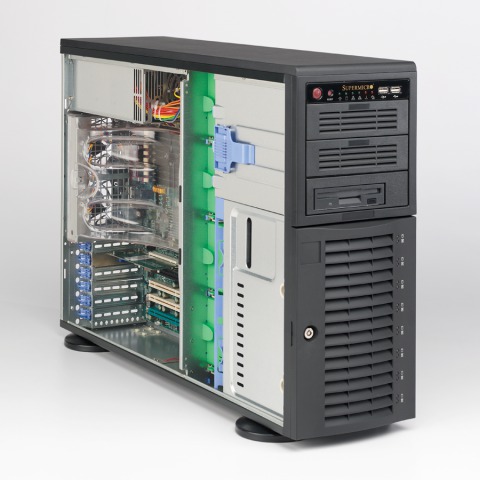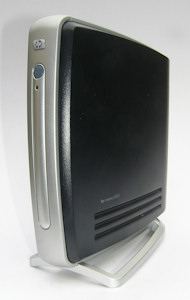Boomtime, the 24 day of Discord in the YOLD 3178
In praise of silent terminals
A while ago I bought a new computer. I asked local company Mullet to build me a Supermicro Superworkstation with a 6 core (* 2 with HT) Intel Xeon W3680 CPU. A real monster of a CPU.
I maxed out the memory with 24 gigs of three-way ECC RAM and had two mirrored 2 TiB disks installed in a 8 piece hot-swap drive bay for storage. Standing right next to it, connected with Gigabit Ethernet, is a fileserver with additional storage.

I call the new box totoro because it's huge and really screams. I just might paint it blue!
I had originally planned to use totoro as a traditional workstation standing under my desk. I even went so far as buying an Nvidia Quadro 600 graphics card so I could hook up both my HP ZR24w 24" displays and even do decent 3D graphics. (Yeah, right, I know. Me using 3D?)
However, the box is very noisy. I can't work in the same room.
Apparently I've been using terminals and fairly silent laptops for so many years that a supposedly whisper-quiet workstation is way too noisy. Of course, the absolutely huge heat-sink necessary on my choice of CPU makes it impossible to use the air shroud that Supermicro is so famous for. That might be one part of the problem. Another is that I'm rather sensitive to noise.
After trying to work with the huge box standing under my desk for a few weeks I finally had enough and moved it into the closet next to the fileserver. Instead, I brought back an old Hewlett-Packard t5125 thin client into service. It was in heavy use as an X terminal from 2005 to 2010.

I connected the t5125 on the second NIC on totoro and created a private network where I could run VNC without SSH tunneling. I think performance would be awful with SSH running on the very slow t5125. Using X instead of VNC would also be way to slow on this terminal if I were to run complicated clients such as, for example, Firefox. For terminal emulators and Emacs frames, however, X would be probably be faster than VNC.
The t5125 is basically a very low-powered PC with a Via Eden (Samuel 2) CPU at 400 MHz, 128 megs of RAM, 32 megs of flash and a 100 Mbit/s Ethernet. It currently runs an ancient Linux booted from a DOM.
Of course, using the t5125 meant I couldn't use any of my 24" monitors, much less both of them at once. Instead I had to make do with an old Samsung 17" LCD I had lying around and using 1280x1024 instead of 1920x1200 (times two).
For a couple of weeks this was rather satisfactory. It worked much better than I anticipated. And, of course, there were no moving parts! Ah! The wonderful silence!
Just the other day my upgrade arrived. It's an HP t5745, a much more modern version of the t5125. Specs: Intel Atom N280 CPU, GL40 chipset (including the GM45 Express GPU), 1 gig RAM expandable to 8 GiB(!), Broadcom gigabit Ethernet and VGA and DisplayPort(!) connections.
I'm a little surprised that these terminals still have a serial port, but that might come in handy for a serial console connection to any embedded projects.
There is no fan. The terminal is dead quiet. It's also cool. Running full speed with a process taking 100% CPU for an hour or so the CPU temperature hits 28 degrees Celsius. Idling CPU temperature seems to be around 21 degrees.
It comes with HP Thinpro, a Debian based GNU/Linux distribution, installed on a 1 GiB DOM. It boots into a selection where you can connect with all sorts of thin client protocols, ICA, RDP and, perhaps more important, XDMCP and SSH. You can also start a local Firefox which seems to work quite well.
VNC is lacking from the connection menu, however, but a TightVNC viewer is installed. You can find it under the Advanced label, start an xterm and then start it with vncviewer. A bit silly, I think, that they didn't include in the standard connection manager.
Anyway, I wasn't going to waste all this CPU power and a gig of RAM just running as a thin client. I'm going to use this as a sort of small workstation.
I experimented for a while booting different Linux distributions from USB sticks. I even tried booting Plan 9 which, I'm sorry to say, didn't work. Finally I installed FreeBSD on a USB stick and that's what I'm running now.
Everything, including sound, seems to work under FreeBSD 9 except for one important thing: the DisplayPort connection. The screen just goes blank if I start X with the monitor on DP. VGA works fine. My guess is that FreeBSD's old X.org simply doesn't support DisplayPort with Intel graphics drivers.
No suprise there, really, since Intel has moved on to work only with KMS/GEM. Coming soon to a FreeBSD distribution near you, I hear. I might experiment with FreeBSD's new KMS/GEM/DRI code eventually but right now I'm busy with other things. The VGA connection and a single 24" monitor at 1920x1200 will have to do for now.
I'm not going to use the local filesystem much except for booting and starting applications because writing to the USB stick it's booting from makes things crawl to a halt. This probably won't be a problem in my scenario but might be a problem for others. Installing the OS on the DOM might help, but I wanted to keep that pristine just in case. Installing a bigger SSD might be an option as well but I don't know if there's any space in the box.
Other than the snag about not being able to use the DisplayPort connection right now, this terminal/light workstation is really, really nice. I'm thinking about buying another so I can have one in the office and one downstairs on a small office desk in the living room.